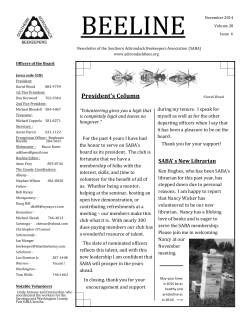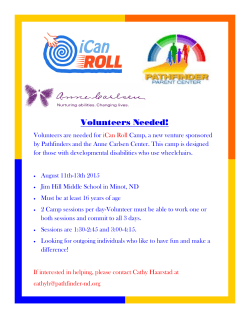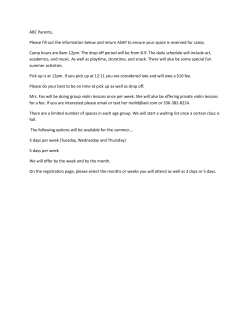
`In the same way one teaches children to be streetwise, I have to
‘In the same way one teaches children to be streetwise, I have to teach mine to be bushwise. They learn how to rely on their senses, watch out for crocodiles and elephants and look at the ground so they don’t step on a scorpion or snake’ 6 AT HOME IN KENYA WITH WILDLIFE EXPERT SABA DOUGLAS-HAMILTON AS SHE TALKS ELEPHANTS, FAMILY ADVENTURES AND THE SHEER NATURAL BEAUTY OF AFRICAN BUSH LIFE Wildlife film-maker and conservationist Saba sits back in the Samburu safari camp, which her mother established in 2001. “It’s one of my favourite places in the world,” she says of the northern Kenya retreat. Her children are likewise enamoured, including eldest daughter Selkie, five (left, with Saba), who takes herds of elephants in her stride. “Elephants symbolise so much – our future, our ability to live on this planet,” says Saba Although they can dine in style in camp (above), Selkie and her three-year-old twin sisters Luna and Mayian opt for a picnic beside the Ewaso Nyrio River (below). “There are always monkeys trying to steal from the children or playing in the trees,” says Saba. “It’s beautiful – unique” Douglas-Hamilton’s daughters turn feral. Kicking off their shoes, the three bush babies climb trees or feed the monkeys, swim in the shallow waters of the river (avoiding the crocodiles) or try to make a fire (with guidance). “I’ll come across them and they’ll be 8 wearing nothing but a little scrap of cloth, gnawing on a great big goat bone surrounded by a load of ferocious-looking warriors with their swords,” says Saba, laughing. “They have an appreciation of the Africa that I had as a child, which is wild Africa.” The wildlife film-maker and conservationist, who was born and raised in Kenya, is sitting under one of the acacia trees that provide shade for the Elephant Watch Camp, built from fallen trees on the sandy banks of the Ewaso Nyrio River. A chorus of birdsong – hornbills and morning thrush, parrots and kingfishers – plays in the background while the wooden bells of goats and camels drinking from the river chime in the distance. It is here that adventurous guests – who have included Natalie Portman, Pierce Brosnan, Isabella Rossellini, Ronnie Wood and family friend and fashion designer Alice Temperley – can stay in one of its six beautifully designed tents and observe at close hand some of the 900-odd elephants that roam free on the Samburu National Reserve. At night guests are often woken by a shower of seed pods raining on the thatched roofs of their tents as elephants feed from the trees. “You will also hear their deep breathing and flatulence,” jokes Saba. The camp and its environment, which is also home to three of the big cat species as well as zebras, gerenuks and giraffes, is the subject of the upcoming ten-part BBC2 documentary series This Wild Life, which follows the daily dramas of the African bush. “It’s a look at our funny little family having a bit of an adventure,” says Saba. “But we’re just a conduit into a place and a way of life,” including that of the Samburu people (cultural cousins to the Masai), many of whom work at the camp. CAMP FOLLOWERS It is the first show that the strikingly beautiful presenter of BBC1’s Big Cat Diary and BBC2’s Unknown Africa has been involved in since the birth of her children. She is usually based in Nairobi with her husband Frank Pope, a marine archeologist, and their daughters Selkie, five, and twins Luna and Mayian, three. But in the past year, desperate to get back V (PREVIOUS PAGE) SABA’S DRESS: ALICE TEMPERLEY. (RIGHT) DRESS: DESIGUAL s soon as they arrive at their A family-run safari camp in Samburu, Northern Kenya, Saba ‘I could live anywhere as long as there’s a wilderness to escape into. For now, our life is here’ Saba, who presented such wildlife programmes as Big Cat Diary and Unknown Africa, and husband Frank Pope, a marine archeologist who now works for his father-in-law Iain Douglas-Hamilton’s charity Save the Elephants, relax with Selkie. Saba says their eldest 9 daughter is “more cautious” when in Samburu, while Luna is “completely fearless” and Mayian “very cerebral” ‘I find the children wearing a little scrap of cloth, gnawing on a goat bone surrounded by ferociouslooking warriors. They have an appreciation of the Africa that I had as a child, which is wild Africa’ into the bush, the family has lived in Samburu to help her Italian mother Oria run the camp, which she established in 2001. It is just four miles downstream from Save the Elephants, a research centre and charity founded by Oria’s husband and Saba’s father Iain Douglas-Hamilton in 1997. A world-renowned elephant conservationist who alerted the world to the dangers of the illegal ivory trade, Iain has been studying the magnificent beasts for years, building a detailed database and an in-depth knowledge of them as individuals. “We have 17 years’ worth of their family history. We know who has mated whom, who is friends with whom, all the dramas that have gone on in their lives. You have some who are grounded and rock solid, others who are completely hysterical and panic at the smallest thing,” says Saba, who has inherited her parents’ passion for the natural world. “It’s like following a soap opera with elephant characters. They take up a lot of our conversation once we start to gossip about them.” The environment, she says, is “pretty close” to idyllic, from her mother’s design – “a wonderful mix of Italian and African flair” – to the rugged, Selkie, Saba, Luna and Mayian relax in a tent that’s draped in multicoloured cottons (above right). As with much of the furniture, the distinctive beds (below) are made from dead trees stripped of their bark by elephants. The magnificent animals also get a look-in on cushions and in the twins’ choice of book (far right) – The Elephant Family written by Saba’s mother Oria. Saba describes the camp, designed by Italian-born Oria, as “a wonderful mix of Italian and African flair” (ABOVE RIGHT) DRESS: SABA’S DRESS: DESIGUAL 10 natural beauty of the wilderness. “I don’t know anywhere like it, it’s unique,” she says. But it’s not without its challenges. There have been floods – four years ago the camp was completely washed away by “a tsunami of water”, which broke the banks of the river. There have been medical emergencies – one of the Samburu men was once gored by an elephant. Luckily he survived. And there are, of course, diseases. BUSH BABIES As much as she loves the freedom and education her children experience living there, Saba is aware of the dangers. “In the same way that one teaches children to be streetwise, I have to teach them to be bushwise,” she says, adding that their once baby-soft feet are now “rough and slightly raspy”. “They learn how to rely on their senses, how to avoid getting thorns in their feet, to watch out for crocodiles in the river, keep an eye out for elephants and always look at the ground to make sure they don’t step on a scorpion or snake. “But you can also teach them to make fire by rubbing sticks together, what fruit they can eat from the bush, how hornbills make their nests – they go on all sorts of adventures.” Often looked after by the Samburu guides, the girls have become fluent in a “different culture and language” that couldn’t be more detached from the “cyber reality” experienced by many children today. “It worries me intensely how cut off people are from the natural world,” says Saba. Being exposed to traditional cultures and customs, she hopes her children will learn skills of survival and selfsufficiency – although each responds differently. Selkie is “more cautious” whereas Luna is “completely fearless” and Mayian “very cerebral”. “I had a situation the other day when the Western mother in me went all a-jitter,” she says, referring to when she stumbled across the twins watching a goat being slaughtered round the back of the camp. “I stood there thinking, ‘Oh my God, they’re going to be traumatised by the blood and guts and the Samburu drinking the blood from the neck.’ I was about to drag them away when Luna turned and said with a great big grin, ‘Mama, lunch!’” she laughs. V DOUBLE TROUBLE When she discovered she was having twins, Saba, who planned to have just two children, went “white with shock” and didn’t speak to her husband “for about three hours”. “I just thought, ‘How are we going to cope?’ But Frank said to me, ‘Look, Subs, life would be so boring if you weren’t thrown a curve ball every now and then.” She likens the experience of having twins to going over a waterfall and “being caught in that thunderous whirlpool at the bottom where you spend a lot of your time under water and only manage to swim up to the surface and gasp every now and again. It has been absolutely intense, but wonderful.” She and Frank are in the process of deciding how best to school the girls; they’ve been attending an international school in Nairobi, but with an increasing amount of time being spent in Samburu, they may have to get a tutor. “I tried to homeschool them but wasn’t very good at it,” says Saba. She met Frank, author and former ocean correspondent for The Times, at a friend’s wedding in Henley in 2004. He changed the seating plan to sit next to her – a bold move that impressed her. “We’re still deeply in love with each other, hugely attracted to each other and have the same set of values. We’re not materialistic people and we’re both adventurers,” she says, explaining what makes their relationship work. “I admire him so much – what he was, who he is, what he’s becoming.” As a sur fer and marine 11 ‘It’s like following a soap opera with elephant characters. They take up a lot of our conversation’ Call of the wild: Selkie – “It’s Gaelic and means ‘seal spirit’,” explains Saba – goes on an elephant safari with Mum (above) and is decorated by Samburu warriors (below) with the patterns they use for their dances. Saba hopes that by exposing her daughters to traditional cultures and customs they will learn skills of survival and self-sufficiency 12 archeologist he misses the sea, but has learnt to fly a Cessna 185 and now surfs the skies instead. He has also joined Save the Elephants as chief of operations, working with Saba’s father to stop the illegal ivory trade. THE YANG’S ALL HERE Saba, who was once tipped to fill the shoes of broadcaster Sir David Attenborough, has fronted many flagship programmes, from Going Ape to The Secret Life of Elephants, has crisscrossed the globe and lived with wild chimpanzees on the Ivory Coast, tracked polar bears in the Arctic and lived with Inuits in Canada. However, when her children arrived, she put that side of her career on hold. “An acupuncturist once said to me, ‘The problem with you is that you’re all yang and no yin.’ And I think film-making is a very yang lifestyle – it’s very male, dynamic and competitive and not conducive to having kids. “I’ve changed a lot. I’ve had to apply myself completely to my family. I can’t go away for long periods and one of us has to be with the kids.” Her mother, who was also brought up in Africa, where she raised Saba and her younger sister Dudu, was an “incredible” role model, says Saba. “She wasn’t only a mother, she was a real hardcore conservationist. There were times when she had to leave us behind to go off and count elephants across Africa with my dad and push the cause and it was hard for me and my sister to be ADDITIONAL PHOTO: SIMON UPTON. (RIGHT) SABA’S DRESS: ALICE TEMPERLEY. (LEFT) DRESS: SALLY DUDMESH V left with a nanny or relative. As a child you feel separation desperately hard. But I would never have changed what they did because I’m so proud of them.” Saba was introduced to her first wild elephant at six weeks old and didn’t go to school until she was seven. But it wasn’t until she was sent to a “ghastly all-girl public school” in England that she realised “how totally and utterly different our life was”. “I learnt to be a chameleon, to put on a certain skin, which I shed when I went back to Africa.” During her ten-year stint at school and university days in Wales, she was looked after by her paternal grandmother, who would take her to the theatre and ballet (which she still loves) and to her croft house on the Isle of Raasay, Scotland, “where I had the most amazing time learning about the British wildlife”. She has said that her career in TV came about because she was “at the right place at the right time” after the BBC became interested in her father’s work. “I miss it desperately,” she The family takes a walk with Samburu warriors (top) – who Saba says make the b u s h c a m p re a l l y special – before they perform the traditional renyatta dance (above), competing to jump the highest while chanting. The warriors played an important role in Saba and Frank’s colourful wedding in 2006 (right), which she describes as “beautiful beyond all expectation”. “As a child I always wanted to be a Samburu warrior,” she says. “They have a very special place in my heart” 13 (LEFT) COAT: ORIA DOUGLAS-HAMILTON. (TOP RIGHT) JACKET: KAPOETA BY AMBICA ‘Frank and I are still deeply in love and have the same values. We’re not materialistic and are both adventurers’ Although Saba put her film-making career on hold to be with her 14 children, she can soon be seen on TV in This Wild Life. “It’s a look at our funny little family having a bit of an adventure,” she says. Meanwhile, she and her girls have a bit of an adventure by climbing onto the Cessna 185 that Frank has learnt to fly (right) says. “I’ve been pining to get out into those remote places that films take you to.” But for the time being she is committed not only to looking after her family but also the elephants that inhabit the land she loves. “It’s a war – we are winning some battles, but we’ve got to keep fighting,” she says of the challenges facing conservationists such as her father, given the grim statistics – between 2010 and 2012, some 100,000 elephants were killed in Africa for their ivory. “They symbolise so much – our future, our ability to live on this planet – and if we can’t save the elephants, what the hell are we going to be able to save?” As the sun begins to set over the vast savannah and the baboons take roost in the high branches of the acacia trees to avoid the leopards, it is time for Saba to round up her children. Can she imagine living anywhere else? She thinks for a bit. With her husband’s passion for the sea, life by the ocean is possible, one day. “I could live in Svalbard,” she says, naming the remote Norwegian archipelago in the Arctic Ocean where she once filmed polar bears. “I could live on the Isle of Raasay. I could live anywhere as long as there was a wilderness to escape into. But for now, our life is very much H here.” INTERVIEW: ROSALIND POWELL PHOTOS: TIM BEDDOW HAIR & MAKE-UP: ALLIE DREW HAIR COLOUR: GARETH JONES FOR CARLTON HAIR JOHANNESBURG Visit elephantwatchportfolio.com and savetheelephants.org. This Wild Life is on BBC2 soon. Saba will give two lectures in spring – at Eden Court in Inverness on 5 March and at The Lyceum in Edinburgh on 9 March.
© Copyright 2025










